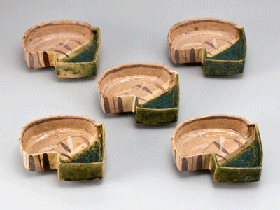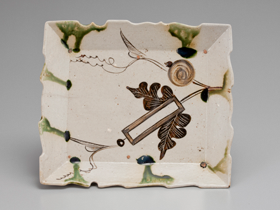美濃桃山陶
Momoyama-period Mino Ware
Back
織部
Oribe
Oribe
織部は、桃山文化が継承される慶長10年(1605年)頃から寛永年間初期頃(1624年‐1628年)まで、美濃地方で生産された陶器です。朝鮮半島から唐津を経由して伝わった連房式登窯が美濃にも導入され、それ以前の大窯と比べて大量に製品を焼くことができるようになりました。器の種類や形もさらに多様になり、広く多くの需要にこたえていたと思われます。
織部で使われる釉薬は、「銅緑釉」を特徴とし、緑色の発色をします。
織部の茶碗は、斬新な器形と多様な装飾が組み合わされることによって、一碗ごとに独特の個性をもちます。歪められて沓形(くつがた)に成形されたデザインには、織部最盛期の独創性が見られます。織部は、器の種類とともに技法の違いによっていくつかの種類に分けられます。
また、大萱の弥七田古窯跡では、作風、施釉、施文に他の織部とは異なった特徴があり、特別に「弥七田織部」と呼ばれています。
つくりは薄手、施釉は銅緑釉をたらして流し、繊細な文様とその描画に赤みがかった鉄絵具(赤楽)を使用するなどの特徴があります。
織部で使われる釉薬は、「銅緑釉」を特徴とし、緑色の発色をします。
織部の茶碗は、斬新な器形と多様な装飾が組み合わされることによって、一碗ごとに独特の個性をもちます。歪められて沓形(くつがた)に成形されたデザインには、織部最盛期の独創性が見られます。織部は、器の種類とともに技法の違いによっていくつかの種類に分けられます。
また、大萱の弥七田古窯跡では、作風、施釉、施文に他の織部とは異なった特徴があり、特別に「弥七田織部」と呼ばれています。
つくりは薄手、施釉は銅緑釉をたらして流し、繊細な文様とその描画に赤みがかった鉄絵具(赤楽)を使用するなどの特徴があります。
Oribe ware is a form of pottery that was produced in the Mino province from around 1605 until the 1620s, a period when Momoyama culture was still very influential. The multi-chambered tunnel kiln (noborigama), which is said to have been initially introduced from the Korean Peninsula to the Karatsu district of Kyūshū, finally made its appearance in the Mino province, making it possible to produce ceramic ware in much greater quantity than with the Ōgama that was utilized prior to this. The types and shapes of the works produced also became more varied and it is believed that this was in answer to increased demand.
Oribe is characterized by its use of ‘green copper glaze’ to produce a rich, green color.
Oribe tea bowls combine novel forms with varied decoration, imbuing each work with a unique individuality. At its peak, the uniqueness of Oribe could be seen in the deformed shapes it employed (known as kutsugata). Oribe ware is divided into various different types according to the shapes and the techniques employed.
In particular, the works produced at the old Yashichida kiln in Ōgaya, display styles, glazes and motifs that are not to be seen on any other Oribe, resulting in them being referred to as ‘Yashichida Oribe’.
These are characteristically thin-walled and have ‘green copper glaze’ applied through pouring, or use delicate motifs with a slight reddish tone achieved through the use of glaze.
Oribe is characterized by its use of ‘green copper glaze’ to produce a rich, green color.
Oribe tea bowls combine novel forms with varied decoration, imbuing each work with a unique individuality. At its peak, the uniqueness of Oribe could be seen in the deformed shapes it employed (known as kutsugata). Oribe ware is divided into various different types according to the shapes and the techniques employed.
In particular, the works produced at the old Yashichida kiln in Ōgaya, display styles, glazes and motifs that are not to be seen on any other Oribe, resulting in them being referred to as ‘Yashichida Oribe’.
These are characteristically thin-walled and have ‘green copper glaze’ applied through pouring, or use delicate motifs with a slight reddish tone achieved through the use of glaze.

鳴海織部草絵向付
Narumi-oribe ware dish with grasses motif.

青織部短冊絵角皿(弥七田織部)
Yashichida-oribe square dish with ‘poem card’ motif.